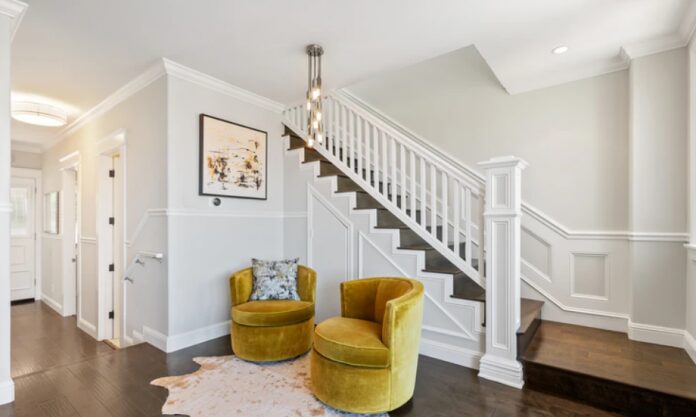Many American houses have unfinished basements used for storage. Many homeowners view finishing a basement as an unnecessary expense. However, expert remodelers and homeowners with finished basements know the value it adds.
A finished basement adds value to a house in different ways. A home with a finished basement is priced higher than one whose basement is unfinished. Further, a finished basement increases the number of rooms in the house. Thus providing more space which means a higher financial valuation of the house and more comfort to those living in it.
Here are several ways finishing a basement adds value to a home.
How Does Finishing A Basement Add Value
A Finished Basement Is An Extra Room

Even with the biggest house, you will still find a use for an extra room. For an average family home, extra room is always welcome. One way to create an extra room in the house is to finish the basement.
You can add an additional bedroom or bathroom by finishing your basement. Depending on where you live and the zoning laws, a bedroom in the basement must have an exit or egress. It can be a window or a full exit to the ground level.
You can also repurpose your finished basement for other uses. You can turn it into your home office or additional storage space to store items that you don’t use regularly. You can also turn it into a home gym or a home theater by installing high-quality entertainment systems.
Attractive Return On Investment
Real estate experts and contractors agree that for every dollar spent to finish a basement, you earn a return of 70 to 75 cents.
This means that if you spend $10,000 to finish your basement, you automatically add $7,500 to the value of your home. This is a monetary value that you can recoup when you decide to sell your home. HomeGardenGuides says the average cost of basement finishing is $1.50 to $4.00 per square foot.
Rent Out Your Basement

To ensure that your basement adds value, you can rent it out if it meets all the legal requirements. When finishing your basement so that you can rent it out, make sure that you pass all inspections and meet all building codes for a habitable dwelling.
The most important is to ensure that your basement has two forms of egress and one form of entrance. Once you pass this inspection, you can plan your basement to make it ideal for a rental property.
If you are going to rent out your finished basement, consider this before you start the remodeling. This allows you to create a floor plan that helps you capture as much natural light as possible into the basement room.
You can use large windows that will allow light into the basement. The more natural light coming into your house, the more attractive it looks to potential tenants. A separate entrance and exit from the main house is another attraction.
Types Of Finished Basements
Walk-Out Basement

Having a walk-out basement as part of your home greatly adds to the value of your home. A walk-out basement is a basement room with an exit that opens to outdoor space. A walk-out basement has large windows and a door that ensure abundant natural light and enhanced safety.
A walk-out basement is commonly found in properties with a slope. Further, it has its main floor above grade or at street level. It will also have ingress and egress as the doors and windows are above grade.
When appraised, a walk-out basement is the most valuable type of basement home can have. It helps to increase the asking price of the property when selling it.
Garden Level Basement
A garden-level basement has some of its parts above grade and another part below grade. The part above grade is appraised to a higher value than that of the part below grade.
Further, a garden-level basement is unlikely to have a door but will have a mix of windows above grade and others below grade.
A garden-level basement is not as valuable as the walk-out basement. However, the design of your basement is mostly determined by the structure of your house. If your house is sloping you can have a garden-level basement. Often, this basement doesn’t have a door.
Full Basement

A full basement has its walls and windows below ground. When it comes to appraising your house the full basement will have a lower value than the walk-out basement.
A full basement is entirely below grade. This means that basement will add very little to the addition as more and more teachers squirm at the event.
How To Evaluate The Financial Value Of Basement
When appraising the value of your property, there are three terms that you need to understand perfectly.
Above grade refers to the house and basement that are not available at the prison cook.
Below grade, basements refer to basements that are below street level.
The gross living area is the total perimeter of the house on the space that is above grade and livable.
When appraisers value your house, they will appraise based on the gross living area. This means that they will ignore areas of the house that are below ground.
After the value of the gross livable area of the house is determined, the basement can then be appraised.
Often, appraisers give the below-grade space a value that is half of the above-grade space. So that, if your house is valued at $200 per foot, the below-grade space is valued at $100.
Many home appraisers follow standards provided by mortgage lenders. Often, these mortgage lenders will not even look at the presence of a finished basement when appraising a building. This leads to a situation where finishing a basement will not add value to your home.
Conclusion
Finishing a basement adds value to your home. Depending on whether the basement is above or below grade, finished basements add value to your house differently.









